
- Home
- Memories
- Scrapbook ▽
- Topics ▽
- People ▽
- Events
- Photos
- Site Map
- Timeline
Also see
List of
other theatres
History of
the Theatre Royal
Theatre Royal Fire
1887
List of casualties
These illustrations, contemporary to the fire, appeared in the Illustrated London News and the Illustrated Police News. Inspecting them closely indicates that some have been produced from original photographs taken after the tragedy, while many are the product of the illustrators imagination. Illustrations printed from etched blocks first regularly appeared in the Illustrated London News in 1842, but it was not until 1891 that the first half-tone photograph was published in a newspaper. The style was often lurid to sell newspapers and the two sets of illustrations from the 1887 Theatre Royal fire tragedy follow the pattern. The Illustrated London News is the more sober in style, using photographs taken by Mr H T Heath of the High Street as the basis for their pictures. They also sent their artist Mr Melton Prior down to Exeter to produce some illustrations directly, ensuring their accuracy. The Illustrated Police News shows quickly executed, imaginative, melodramatic moments, such as an actress escaping through a window, for which there would have only been eyewitness statements to base the illustration on.
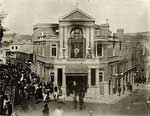 An original photograph of the
Theatre Royal after the fire, showing the burnt out shell. The shell
would be retained for the new, safer Theatre Royal that was built on
the same site and opened the next year. It is probable that the crowd
were massed in New North Road because the entrance to the stables,
where the bodies of the victims were laid out, were opposite this side
of the theatre.
An original photograph of the
Theatre Royal after the fire, showing the burnt out shell. The shell
would be retained for the new, safer Theatre Royal that was built on
the same site and opened the next year. It is probable that the crowd
were massed in New North Road because the entrance to the stables,
where the bodies of the victims were laid out, were opposite this side
of the theatre.
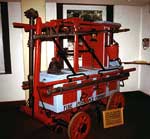 The original fire-engine that
attended the blazing theatre. Belonging to the West of England Fire
Insurance Company, it arrived within a few minutes, but was clearly not
able to make an impression on the fire. It now belongs to AXA Insurance.
The original fire-engine that
attended the blazing theatre. Belonging to the West of England Fire
Insurance Company, it arrived within a few minutes, but was clearly not
able to make an impression on the fire. It now belongs to AXA Insurance.

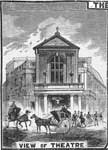 A
lively illustration of people arriving at the theatre for the final
performance. The whole front page had across the top "The Burning of Exeter Theatre - Shocking
Scenes."
A
lively illustration of people arriving at the theatre for the final
performance. The whole front page had across the top "The Burning of Exeter Theatre - Shocking
Scenes."
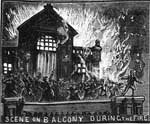 An imaginative illustration of the
fire with the caption "Scene on
balcony during the fire." Many in the dress circle escaped to
the upper foyer which was linked via a vestibule to what was described
as a portico. Ladders were used to get some down from the outside
balcony, but some, in their terror jumped into the street and were
killed.
An imaginative illustration of the
fire with the caption "Scene on
balcony during the fire." Many in the dress circle escaped to
the upper foyer which was linked via a vestibule to what was described
as a portico. Ladders were used to get some down from the outside
balcony, but some, in their terror jumped into the street and were
killed.

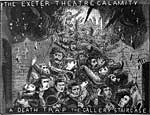 Accompanied by the lurid caption "The Exeter Theatre Calamity - A death trap
the gallery staircase", this illustration is the Victorian
equivalent of a News of the World illustration.
Accompanied by the lurid caption "The Exeter Theatre Calamity - A death trap
the gallery staircase", this illustration is the Victorian
equivalent of a News of the World illustration.
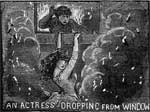 Another
Illustrated Police News depiction of a dramatic moment with the caption
"An actress dropping from window."
Billowing smoke and sparks surround the girl, leaving it to the
imagination about where she will end up.
Another
Illustrated Police News depiction of a dramatic moment with the caption
"An actress dropping from window."
Billowing smoke and sparks surround the girl, leaving it to the
imagination about where she will end up.

 This
illustration is captioned "Fatal fire
Exeter theatre burns". It shows members of the audience leaping
from the dress circle while the cast leap off the stage pursued by a
billowing mass of flame.
This
illustration is captioned "Fatal fire
Exeter theatre burns". It shows members of the audience leaping
from the dress circle while the cast leap off the stage pursued by a
billowing mass of flame.
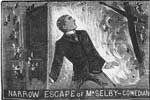 "Narrow
escape of Mr Selby - comedian" shows one of the cast at a door
as he escapes. The artist has included a burning cross motif as though
he is being protected by his faith.
"Narrow
escape of Mr Selby - comedian" shows one of the cast at a door
as he escapes. The artist has included a burning cross motif as though
he is being protected by his faith.

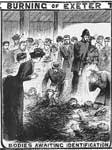 Compare this illustration with a
similar, more sober version in the Illustrated London News below.
Captioned "Bodies awaiting
identification" it shows a large crowd with distraught
individuals identifying bodies.
Compare this illustration with a
similar, more sober version in the Illustrated London News below.
Captioned "Bodies awaiting
identification" it shows a large crowd with distraught
individuals identifying bodies.
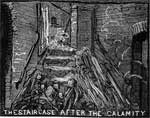 A rough and ready illustration of "The staircase after the calamity"
shows a still smoking ruin that does not bear much resemblance to the
similar version from the Illustrated London News of the pay box below.
A rough and ready illustration of "The staircase after the calamity"
shows a still smoking ruin that does not bear much resemblance to the
similar version from the Illustrated London News of the pay box below.

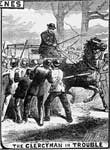 One of the funerals ended with the
crowd accusing the minister presiding over the ceremony of drunkenness.
The Rev. John Ingle, Rector of St Olaves appeared on the 13 September
before Justices at the Castle charged with being drunk in Exeter
Cemetery. It was claimed that he appeared to be staggering and mumbling
at the head of the funeral party. After three attempts to conduct the
ceremony, he is said to have walked unsteadily away, while mourners
demand he return and finish the proceedings. Police officers arrived
and he was arrested. In the event, the magistrate thought the evidence
contradictory and he dismissed the case.
One of the funerals ended with the
crowd accusing the minister presiding over the ceremony of drunkenness.
The Rev. John Ingle, Rector of St Olaves appeared on the 13 September
before Justices at the Castle charged with being drunk in Exeter
Cemetery. It was claimed that he appeared to be staggering and mumbling
at the head of the funeral party. After three attempts to conduct the
ceremony, he is said to have walked unsteadily away, while mourners
demand he return and finish the proceedings. Police officers arrived
and he was arrested. In the event, the magistrate thought the evidence
contradictory and he dismissed the case.
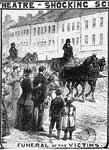 Many
turned out for the funerals of the victims and here, the IPN artist has
captured the scene and captioned "Funeral
of the victims."
Many
turned out for the funerals of the victims and here, the IPN artist has
captured the scene and captioned "Funeral
of the victims."

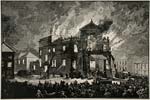 An imaginative
illustration of the scene of the fire. However, the accuracy of the
drawing suggests it was based on a photograph of the building.
An imaginative
illustration of the scene of the fire. However, the accuracy of the
drawing suggests it was based on a photograph of the building.
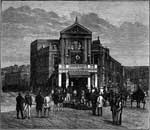 This illustration shows the
theatre after the fire with people standing around, wondering 'what
next'. It is from a photograph by Mr H T Heath a local photographer
from the High Street.
This illustration shows the
theatre after the fire with people standing around, wondering 'what
next'. It is from a photograph by Mr H T Heath a local photographer
from the High Street.

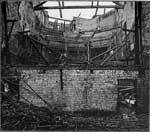 This finely detailed
illustration was also probably based on a photograph from Mr Heath, as
the Illustrated London News mentions that at least one interior
illustration was based on a photo. It indicates the care that the
Illustrated London News took over accuracy.
This finely detailed
illustration was also probably based on a photograph from Mr Heath, as
the Illustrated London News mentions that at least one interior
illustration was based on a photo. It indicates the care that the
Illustrated London News took over accuracy.
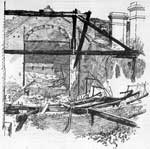 The
wrecked gallery - the looser style, than the preceding illustration,
suggests it was drawn by Mr Price after the event.
The
wrecked gallery - the looser style, than the preceding illustration,
suggests it was drawn by Mr Price after the event.

 The remains of the dress
circle showing the supporting columns still intact, while two seats can
be discerned at the rear. Again, care has been taken to make an
accurate record.
The remains of the dress
circle showing the supporting columns still intact, while two seats can
be discerned at the rear. Again, care has been taken to make an
accurate record.
 The
dressing room was beneath the stage - the illustration shows the dark,
narrow passage that led to the dressing rooms, and how difficult it
would have been to escape when filled with smoke.
The
dressing room was beneath the stage - the illustration shows the dark,
narrow passage that led to the dressing rooms, and how difficult it
would have been to escape when filled with smoke.

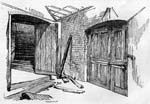 This exterior door at the
bottom of the stairs appears to be still bolted. Many victims died of
smoke inhalation, as fumes were carried up the stairs which acted like
a flue. Probably drawn at the scene by Mr Price.
This exterior door at the
bottom of the stairs appears to be still bolted. Many victims died of
smoke inhalation, as fumes were carried up the stairs which acted like
a flue. Probably drawn at the scene by Mr Price.
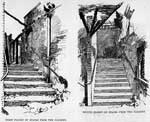 Two views of the staircases -
many victims were found face down, piled up higher than the handrails
on each side, as someone leading, tripped, and those behind pushed down
and fell on top.
Two views of the staircases -
many victims were found face down, piled up higher than the handrails
on each side, as someone leading, tripped, and those behind pushed down
and fell on top.

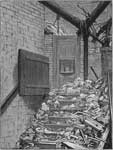 This pay box caused a blockage
as people tried to escape down the stairs. One survivor stated "All the doors were open, but the check-box
was left in the doorway at the head of the stairs. I kicked the box
aside."
This pay box caused a blockage
as people tried to escape down the stairs. One survivor stated "All the doors were open, but the check-box
was left in the doorway at the head of the stairs. I kicked the box
aside."
 A surprisingly graphic
illustration of the bodies laid out at the New London Inn. This may be
based on a verbal description plus Mr Price the artist visiting the
stable. Compare the style with the far more lurid equivalent from the
Illustrated Police News above.
A surprisingly graphic
illustration of the bodies laid out at the New London Inn. This may be
based on a verbal description plus Mr Price the artist visiting the
stable. Compare the style with the far more lurid equivalent from the
Illustrated Police News above.

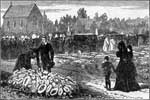 The Illustrated London News
published its graphic account of the fire 12 days after the event. This
gave time for this illustration of a funeral at Higher Cemetery to be
prepared. It was probably drawn at the event by the paper's artist,
judging from the accurate portrayal of the two chapels at the cemetery.
The Illustrated London News
published its graphic account of the fire 12 days after the event. This
gave time for this illustration of a funeral at Higher Cemetery to be
prepared. It was probably drawn at the event by the paper's artist,
judging from the accurate portrayal of the two chapels at the cemetery.
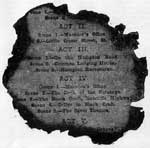 A
burnt scrap of the play bill for acts 2 to 5 of Romany Rye, the play
that was showing on the evening of the fire.
A
burnt scrap of the play bill for acts 2 to 5 of Romany Rye, the play
that was showing on the evening of the fire.

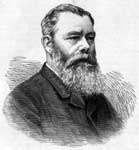 Robert Pople was the owner of
the New London Inn, whose stables were used to lay out the bodies, and
which took in many stunned and wounded playgoers. On the first alarm.
Mr Pople "brought six or eight
ladders, by which fifty or sixty people were rescued; he also gave the
services of his entire household to the reception of the dead and
living sufferers."
Robert Pople was the owner of
the New London Inn, whose stables were used to lay out the bodies, and
which took in many stunned and wounded playgoers. On the first alarm.
Mr Pople "brought six or eight
ladders, by which fifty or sixty people were rescued; he also gave the
services of his entire household to the reception of the dead and
living sufferers."
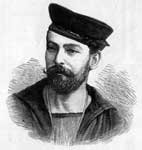 Seaman William Hunt, right, of
HMS Express helped to rescue the living and retrieve the dead - the
illustration is based on a photograph by Mr Heath. Driver George Cooper
of the Royal Artillery was also praised, while Bombardier Scattergood
who was in the audience, saved many around him before he died of his
injuries.
Seaman William Hunt, right, of
HMS Express helped to rescue the living and retrieve the dead - the
illustration is based on a photograph by Mr Heath. Driver George Cooper
of the Royal Artillery was also praised, while Bombardier Scattergood
who was in the audience, saved many around him before he died of his
injuries.
│ Top of Page │